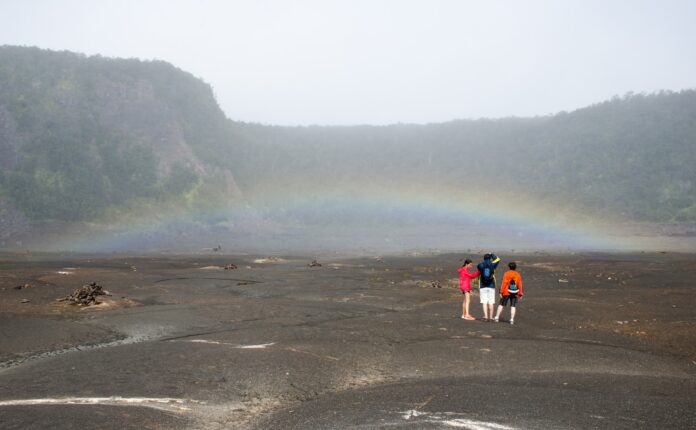The Hawaiian Islands, with their unique landscapes and rich cultural history, offer countless opportunities for exploration and adventure. For those arriving in Hilo, the gateway to the Big Island, one of the most popular and awe-inspiring excursions is a visit to Volcanoes National Park and Rainbow Falls. This shore excursion combines the raw, volcanic power of the island with the tranquil beauty of its lush rainforests, offering a comprehensive look at what makes Hawaii so special.
Introduction to Hilo and Its Natural Wonders
Hilo, located on the eastern side of the Big Island, is known for its lush landscapes, abundant rainfall, and vibrant Hawaiian culture. Unlike the sunny beaches of Kona, Hilo is surrounded by dense rainforests, cascading waterfalls, and volcanic terrain. This combination of natural beauty and geological activity makes it an ideal starting point for exploring two of the island’s most iconic sites: Volcanoes National Park and Rainbow Falls.
Why Visit Volcanoes National Park and Rainbow Falls?
Volcanoes National Park
Home to two of the world’s most active volcanoes, Kīlauea and Mauna Loa, Volcanoes National Park offers a glimpse into the powerful forces that have shaped the Hawaiian Islands. The park covers over 330,000 acres of diverse landscapes, including lava fields, rainforests, and volcanic craters. Visitors can witness the ongoing process of island creation, as lava flows from Kīlauea continuously reshape the landscape.
Rainbow Falls
Just a short drive from Hilo’s city center, Rainbow Falls is a stunning 80-foot waterfall that cascades into a large, tranquil pool. The falls are named for the rainbows that often form in the mist created by the rushing water. Surrounded by lush, tropical vegetation, Rainbow Falls is a perfect example of Hawaii’s natural beauty and is easily accessible, making it a popular spot for visitors.
Exploring Volcanoes National Park
Kīlauea Visitor Center
Introduction to the Park
The Kīlauea Visitor Center is the ideal first stop in Volcanoes National Park. Here, you can gather information about the park, including current volcanic activity, trail conditions, and safety guidelines. The center offers informative exhibits about the park’s geology, ecosystems, and cultural history, providing valuable context for your visit.
Ranger-Led Programs
For those interested in a deeper understanding of the park, the Kīlauea Visitor Center offers ranger-led programs and guided walks. These programs provide insights into the volcanic activity, the native plants and animals of the park, and the cultural significance of the area to Native Hawaiians. Participating in a ranger-led program is an excellent way to enhance your experience and learn more about this unique environment.
Chain of Craters Road
Scenic Drive
One of the most popular routes in Volcanoes National Park is the Chain of Craters Road, a scenic drive that takes you through a variety of volcanic landscapes. The road begins near the Kīlauea Visitor Center and descends over 3,700 feet to the coast, passing numerous craters, lava flows, and scenic viewpoints along the way.
Puʻu Huluhulu
A notable stop along the Chain of Craters Road is the Puʻu Huluhulu trail, a short hike to a forested cinder cone. The trail offers panoramic views of the surrounding lava fields and the nearby Mauna Ulu shield volcano. The hike is relatively easy and suitable for all ages, making it a great option for those looking to stretch their legs and enjoy the scenery.
End of the Road
At the end of the Chain of Craters Road, you’ll reach the Holei Sea Arch, a natural arch carved by the relentless forces of the ocean. The sea arch is a testament to the dynamic nature of the coastline, where lava flows have created new land that is constantly being reshaped by the waves. This is also the area where you can observe the most recent lava flows that have reached the ocean, providing a dramatic finale to your scenic drive.
Crater Rim Drive
Halemaʻumaʻu Crater
One of the highlights of any visit to Volcanoes National Park is the Halemaʻumaʻu Crater, a massive volcanic crater located within the larger Kīlauea Caldera. The crater is known for its frequent eruptions, which have created a lava lake that can often be seen from the crater’s rim. The Crater Rim Drive offers several viewpoints where you can safely observe this powerful natural phenomenon. On clear days, you may even see plumes of steam and gas rising from the crater, a reminder of the ongoing volcanic activity beneath the surface.
Thurston Lava Tube
Another must-see attraction along the Crater Rim Drive is the Thurston Lava Tube, a tunnel formed by flowing lava that has since solidified. Visitors can walk through the lava tube, which is illuminated to showcase the unique textures and formations created by the cooling lava. The lava tube is surrounded by a lush rainforest, providing a stark contrast to the barren lava fields found elsewhere in the park.
Devastation Trail
For those interested in the destructive power of volcanic eruptions, the Devastation Trail offers a sobering look at the aftermath of the 1959 Kīlauea Iki eruption. The trail passes through an area that was once covered in dense forest, but is now a barren landscape of cinders and ash. Interpretive signs along the trail explain the eruption’s impact on the environment and the gradual process of ecological recovery.
Jaggar Museum (Temporarily Closed)
Volcano Monitoring
Although the Jaggar Museum is currently closed due to damage sustained during the 2018 eruption, it was once the premier destination for learning about volcano monitoring and the science of volcanology. The museum housed exhibits on the tools and techniques used to monitor volcanic activity, as well as information about the history of Kīlauea and other Hawaiian volcanoes. The museum’s closure has shifted much of the educational focus to the Kīlauea Visitor Center, but the site still offers incredible views of the Halemaʻumaʻu Crater.
Discovering Rainbow Falls
A Natural Wonder
Accessible Beauty
Rainbow Falls is one of the most accessible waterfalls on the Big Island, located just a few minutes from downtown Hilo. The falls are easily reached by car, and the viewing platform is only a short walk from the parking area. This makes Rainbow Falls an ideal stop for visitors of all ages and abilities, whether you’re looking for a quick photo opportunity or a peaceful place to relax and enjoy nature.
Best Time to Visit
The best time to visit Rainbow Falls is in the early morning, when the sun is low in the sky and the chances of seeing a rainbow in the mist are highest. The soft morning light also enhances the colors of the surrounding vegetation, making for beautiful photos. If you visit after a period of heavy rain, the waterfall will be particularly full and powerful, adding to the dramatic effect.
Exploring the Surrounding Area
Wailuku River State Park
Rainbow Falls is part of Wailuku River State Park, which also includes the nearby Boiling Pots and Peʻepeʻe Falls. The Boiling Pots are a series of terraced pools connected by cascading waterfalls, creating a dynamic and visually striking landscape. The pools are named for the turbulent water that seems to boil as it rushes through the narrow channels. Peʻepeʻe Falls, located upstream from the Boiling Pots, is a lesser-known but equally beautiful waterfall, offering a more secluded experience for those willing to explore further.
Liliʻuokalani Gardens
After visiting Rainbow Falls, consider stopping by Liliʻuokalani Gardens, a serene Japanese-style garden located on the waterfront in Hilo. The gardens feature traditional Japanese architecture, koi ponds, stone lanterns, and meticulously landscaped grounds, providing a peaceful retreat from the hustle and bustle of the city. It’s a great place to unwind and reflect on your day’s adventures.
Tips for a Great Hilo Shore Excursion
What to Bring
Comfortable Clothing
Hilo’s weather can be unpredictable, with frequent rain showers and varying temperatures. Dress in comfortable, breathable clothing that can handle both warm sun and cool rain. Layering is recommended, as it allows you to adjust to changing conditions throughout the day.
Sturdy Footwear
While much of the shore excursion involves easy walks, some areas, particularly in Volcanoes National Park, may have uneven terrain or rocky paths. Wear sturdy, closed-toe shoes that provide good support and traction, especially if you plan to hike any of the trails.
Rain Gear
Given Hilo’s reputation as one of the wettest cities in the United States, it’s a good idea to bring rain gear, such as a lightweight rain jacket or poncho. This will keep you dry and comfortable, even if you encounter a sudden downpour.
Camera
The natural beauty of Volcanoes National Park and Rainbow Falls makes this shore excursion a photographer’s dream. Bring a camera to capture the stunning landscapes, vibrant colors, and unique geological features. If you have a waterproof camera or a camera with a rain cover, that’s even better, as it will allow you to shoot in any weather.
Respecting the Environment
Leave No Trace
Hawaii’s natural environment is fragile and should be treated with respect. Follow the principles of Leave No Trace by staying on designated trails, disposing of waste properly, and not disturbing the wildlife or vegetation. By doing so, you’ll help preserve these beautiful places for future generations to enjoy.
Cultural Sensitivity
Many of the sites you visit, particularly in Volcanoes National Park, hold cultural significance for Native Hawaiians. Be mindful of this and approach your visit with respect and sensitivity. Follow any posted guidelines and listen to the advice of your guides to ensure that you are honoring the cultural heritage of the area.
Booking Your Shore Excursion
To experience the best of Hilo, including Volcanoes National Park and Rainbow Falls, consider booking a shore excursion that includes transportation, guided tours, and all the necessary amenities. A well-organized tour ensures that you make the most of your limited time in port and enjoy a seamless, stress-free experience.
For an easy and convenient way to book your shore excursion, visit Viator, where you can find a variety of tours and activities to suit your interests. Whether you’re looking for a comprehensive guided tour or a more independent exploration, Viator offers a range of options to help you plan your perfect day in Hilo.
Disclaimer: The information provided in this article is accurate to the best of our knowledge at the time of writing. However, details of the tour, including itinerary, availability, and health protocols, may change. We recommend checking the booking pages on Viator for the most up-to-date information.
For more travel tips and inspiration, visit Izase to explore a wide range of destinations and experiences around the world.
MORE FROM IZASE


